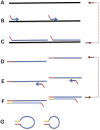The applications of single-cell genomics
- PMID: 23922233
- PMCID: PMC3782075
- DOI: 10.1093/hmg/ddt377
The applications of single-cell genomics
Abstract
We all start out as a single totipotent cell that is programmed to produce a multicellular organism. How do individual cells make those complex developmental switches? How do single cells within a tissue or organ differ, how do they coordinate their actions or go astray in a disease process? These are long-standing and fundamental questions in biology that are now becoming tractable because of advances in microfluidics, DNA amplification and DNA sequencing. Methods for studying single-cell transcriptomes (or at least the polyadenylated mRNA fraction of it) are by far the furthest ahead and reveal remarkable heterogeneity between morphologically identical cells. The analysis of genomic DNA variation is not far behind. The other 'omics' of single cells pose greater technological obstacles, but they are progressing and promise to yield highly integrated large data sets in the near future.
Figures


References
-
- Bendall S.C., Nolan G.P. From single cells to deep phenotypes in cancer. Nat. Biotechnol. 2012;30:639–647. - PubMed
Publication types
MeSH terms
Grants and funding
LinkOut - more resources
Full Text Sources
Other Literature Sources

